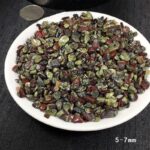Light pink precious stones have captivated hearts for centuries, exuding a ethereal beauty and alluring charm. From delicate morganite to vibrant tourmaline, these gemstones embody the essence of femininity, grace, and sophistication. In this comprehensive guide, we uncover the captivating world of light pink precious stones, exploring their unique properties, remarkable uses, and enchanting folklore.

Morganite: The Delicate Embrace of Rose Quartz and Aquamarine
Morganite, a mesmerizing member of the beryl family, is celebrated for its captivating shade of pale pink. Discovered in 1910, it was named after the renowned financier J.P. Morgan. With a hardness of 7.5-8 on the Mohs scale, morganite exhibits exceptional durability, making it suitable for a wide range of jewelry applications.
Key Properties:
- Pink to peachy-pink hue
- Transparent to semi-transparent clarity
- Hardness of 7.5-8 on the Mohs scale
- Chemical composition: Be3Al2(SiO3)6
Notable Occurrences:
- Brazil
- Madagascar
- Afghanistan
- Mozambique
Application Spectrum:
- Earrings and necklaces
- Rings and bracelets
- Pendants and brooches
Kunzite: The Pastel Pink Symphony of Lithium
Kunzite, a fascinating variety of spodumene, emits a delicate pink shimmer that ranges from light purple to soft rose. Its name honors the renowned mineralogist George Frederick Kunz, who identified it in 1902. Possessing a hardness of 7-7.5 on the Mohs scale, kunzite is a relatively durable gemstone for jewelry wear.
Key Properties:
- Pale pink to lavender-purple hue
- Transparent to semi-transparent clarity
- Hardness of 7-7.5 on the Mohs scale
- Chemical composition: LiAlSi2O6
Notable Occurrences:
- Afghanistan
- Madagascar
- Brazil
- United States
Application Spectrum:
- Earrings and pendants
- Necklaces and bracelets
- Rings and engagement rings
Pink Tourmaline: The Vibrant Spectrum of a Rainbow’s Blush
Pink tourmaline, a captivating member of the tourmaline family, showcases a vibrant range of hues, from soft pastels to rich magentas. Its popularity stems from its exceptional fire and brilliance, which illuminate its inner depths. With a hardness of 7-7.5 on the Mohs scale, pink tourmaline offers durability for various jewelry designs.
Key Properties:
- Pink to purplish-red hue
- Transparent to translucent clarity
- Hardness of 7-7.5 on the Mohs scale
- Chemical composition: Na(Li1.5Al1.5)Al6(BO3)3Si6O18(OH)4
Notable Occurrences:
- Brazil
- Nigeria
- Madagascar
- Sri Lanka
Application Spectrum:
- Stud earrings and drop earrings
- Necklaces and bracelets
- Rings and pendants
Rhodonite: The Earthy Elegance of Manganese’s Embrace
Rhodonite, an opaque and captivating gemstone, displays a distinctive pink hue with black banding. Its name originates from the Greek word “rhodos,” meaning “rose.” With a hardness of 5.5-6.5 on the Mohs scale, rhodonite is a delicate gemstone that requires careful handling.
Key Properties:
- Opaque with rose-red hue and black banding
- Hardness of 5.5-6.5 on the Mohs scale
- Chemical composition: MnSiO3
Notable Occurrences:
- Russia
- Australia
- Mexico
- United States
Application Spectrum:
- Cabochons for pendants and brooches
- Beads for necklaces and bracelets
- Inlay work on rings and earrings
Pink Sapphire: A Kiss of Radiance from Corundum’s Embrace
Pink sapphire, a captivating variety of corundum, exudes an ethereal pink glow that has captivated royals and collectors for centuries. With a hardness of 9 on the Mohs scale, it is one of the most durable gemstones, making it suitable for exquisite jewelry designs.
Key Properties:
- Pink to purplish-pink hue
- Transparent to translucent clarity
- Hardness of 9 on the Mohs scale
- Chemical composition: Al2O3
Notable Occurrences:
- Sri Lanka
- Madagascar
- Thailand
- Australia
Application Spectrum:
- Engagement rings and necklaces
- Earrings and pendants
- Bracelets and cufflinks
Common Mistakes to Avoid When Selecting Light Pink Precious Stones
- Confusion with Other Gemstones: Be cautious of gemstones that resemble light pink precious stones, such as rose quartz or pink topaz. Verify the stone’s authenticity through a reputable jeweler or gemologist.
- Clarity Issues: Avoid selecting gemstones with excessive inclusions or fractures, as they can compromise the stone’s durability and aesthetic appeal.
- Damaged Surfaces: Inspect the stone carefully for any scratches or nicks on the surface. These imperfections can detract from the gemstone’s brilliance and value.
- Color Misrepresentation: Lighting conditions can alter the appearance of light pink precious stones. Examine the stone under various lighting conditions to ensure accurate color assessment.
- Overpayment: Research the market value of light pink precious stones to avoid paying excessive prices. Compare prices from reputable sellers before making a purchase.
Step-by-Step Approach to Selecting the Perfect Light Pink Precious Stone
- Determine the Hue and Saturation: Choose a pink hue that complements your skin tone and personal preferences. Consider the level of saturation, from soft pastels to vibrant magentas.
- Assess Clarity: Opt for a gemstone with minimal inclusions or fractures. Excellent clarity enhances brilliance and transparency, maximizing the stone’s beauty.
- Evaluate Carat Weight: The carat weight of a gemstone refers to its weight in carats. Larger gemstones have a more prominent presence while smaller ones are more delicate. Select a carat weight that suits your jewelry design and budget.
- Consider the Cut: The cut of a gemstone influences its brilliance and shape. Choose a cut that optimizes the stone’s natural beauty and complements its intended jewelry application.
- Set in a Complementary Setting: Opt for a setting that enhances the stone’s color and brilliance. Consider metal options that harmonize with the stone’s hue, such as platinum, white gold, or rose gold.
Frequently Asked Questions about Light Pink Precious Stones
1. Which light pink precious stone is most durable?
Pink sapphire is the most durable light pink precious stone with a hardness of 9 on the Mohs scale.
2. What is the most affordable light pink precious stone?
Morganite is typically the most affordable light pink precious stone, making it an excellent choice for budget-conscious buyers.
3. Are light pink precious stones suitable for everyday wear?
Yes, light pink precious stones with a hardness of 7 or higher, such as morganite, kunzite, and pink tourmaline, are suitable for everyday wear with proper care.
4. What jewelry designs are most popular for light pink precious stones?
Light pink precious stones are commonly used in engagement rings, necklaces, earrings, and pendants, adding a touch of elegance and femininity to any outfit.
5. Are there any unique applications for light pink precious stones?
Light pink precious stones can be incorporated into various decorative elements, such as inlays in furniture, accents in artwork, and embellishments on clothing and accessories.




























